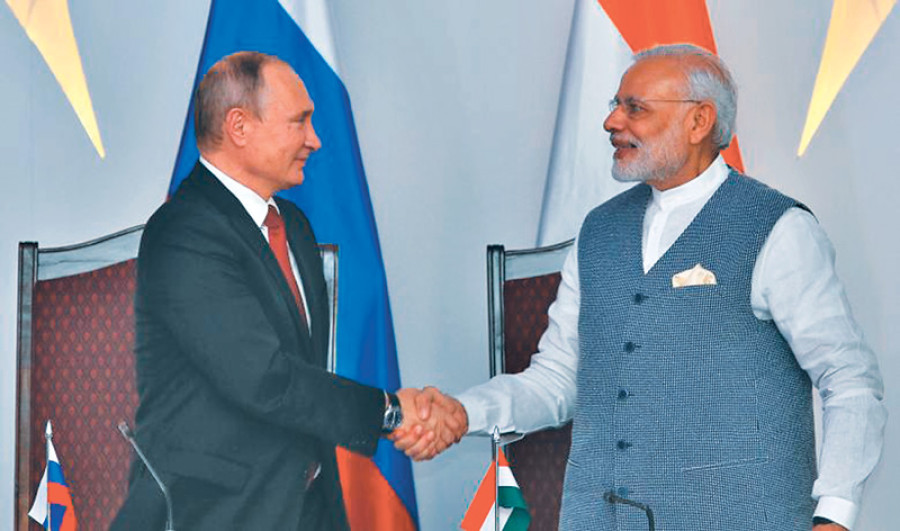Opinion
Russia-India arms deal
The pact changed the distribution of power and ties among major Asian countries
Madan Shahi
The eighth Brics Summit in Goa concluded with some general agreements and negotiations on a wide range of aspects to concretise economic policies, but the India-Russia arms deal made through informal processes on the sidelines of the summit was a major pact which changed the distribution of power and relations among powerful Asian countries. Indian Prime Minister Modi cited the necessity to build capabilities to respond to terrorism for the acquisition of highly sophisticated arms, but geo-political rivalry and hostility with the immediate north and west seem to be the motivating factor. This excuse is similar to the one the then Indian prime minister Vajpayee gave during the 1998 nuclear test that the threat posed to India from China being a nuclear state required it to go nuclear.
The US-Pakistan alliance for the global war on terrorism limited US assistance to India in terms of technology transfer to modernise its military. This encouraged India to make an arms deal with Russia. Since Russia is one of the most unfriendly countries to the US, the Americans would not be pleased with India’s deal with the Russians. This does not mean India has antagonised the West. A disappointed US might impose some diplomatic pressure against India’s bid to get a permanent seat at the UN Security Council, but it can rely on this democratic ally and easily lure it to its side. So the US will cautiously take steps to bring India to its side as an all-weather ally to balance Chinese power in Asia.
Russian calculations
Though India pursued a non-aligned policy during the Cold War, it allied with Russia strategically and enjoyed financial assistance from the US. Its 1998 nuclear test brought rapprochement with the US and it benefitted from the import of highly advanced nuclear technology and military hardware. The two were in agreement with regard to defence and counterterrorism. In spite of this, Russia cooperated with India and provided technology to develop submarines and artillery. Energy-rich Russia’s economy is highly dependent on oil and gas exports, and it also has a highly developed arms industry capable of competing in the global market. But its deteriorating relations with the West and stagnating economy as a result of European Union sanctions has made it look towards Asia for markets, particularly China with its swelling energy demand and India with its arms demand.
Russian President Putin has certain calculations behind the arms deal with India. One, Russia wants to reengage with its traditional ally when its strong allies in the Middle East are either war-torn or becoming less hostile towards the West like Syria and Iran respectively. Two, India is never expected to become a threat to Russia due to historical relations and location. Three, it is hard to bear the truth of a rising China occupying its space so it intends to take preventive measures; and India may be a potential player to balance growing Chinese power. Four, Russia wants to promote research and development in its arms industry and create jobs for research personnel in order to come out of an economic recession.
Nepal’s concerns
The Brics Summit undeniably helped strengthen cooperation among the member countries in multiple sectors, but the activities hidden from the main agenda became a large stone that Chinese President Xi Jinping had to swallow. As long as the issue of India-China territorial claims is not settled, China will be reminded of their war in 1962 and its inability to assist all-weather ally Pakistan against Indian intervention when East Pakistan seceded and became Bangladesh.
India, a strong naval power, can more effectively strike through its land mass with a stronger military. But China’s per capita gross domestic product (GDP) is not more than that of the Asian Tigers, and it has to make much more progress. China’s rise depends on maintaining economic growth and political stability in the country and the region. So China is expected to deal with Russia by exerting diplomatic pressure rather than by declining opportunities to access Russian energy resources. But it is cautious about Russia’s unpredictable behaviour, considering their split and border war in 1969.
Pakistan is troubled by terrorism, and it is deeply engaged in the fight to exterminate Muslim radicals and suppress separatists in Baluchistan. These issues are the core hindrances to its economic growth. It is unable to increase military spending to confront these threats. With India seemingly trying to isolate Pakistan, it will push for military modernisation, fuelling security concerns among countries hostile to it.
The member states of the South Asian Association for Regional Cooperation (Saarc) will find it hard to adjust their foreign policy in the context of the changed geopolitical environment. For politically unstable and landlocked Nepal, it will be much harder. The uncertainty about Xi’s visit to Nepal might be an indication of his dissatisfaction with the 25-point joint statement issued by the Nepali and Indian prime ministers last September. Moreover, growing India-Pakistan enmity will lead to the failure of Saarc, and Sino-India distrust will create a threat to regional security.
Shahi has a master’s degree from Jindal School of International Affairs, India and is a part-time lecturer at MIRD-TU




 16.24°C Kathmandu
16.24°C Kathmandu












